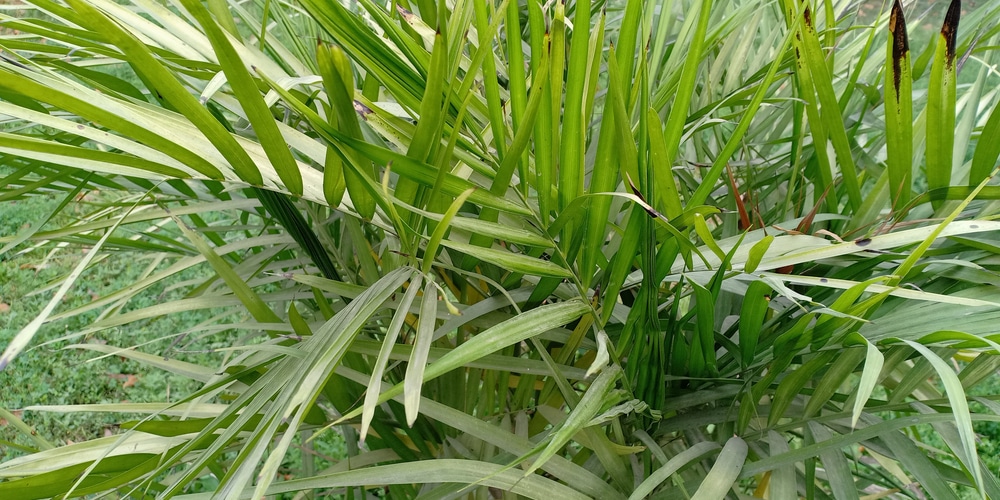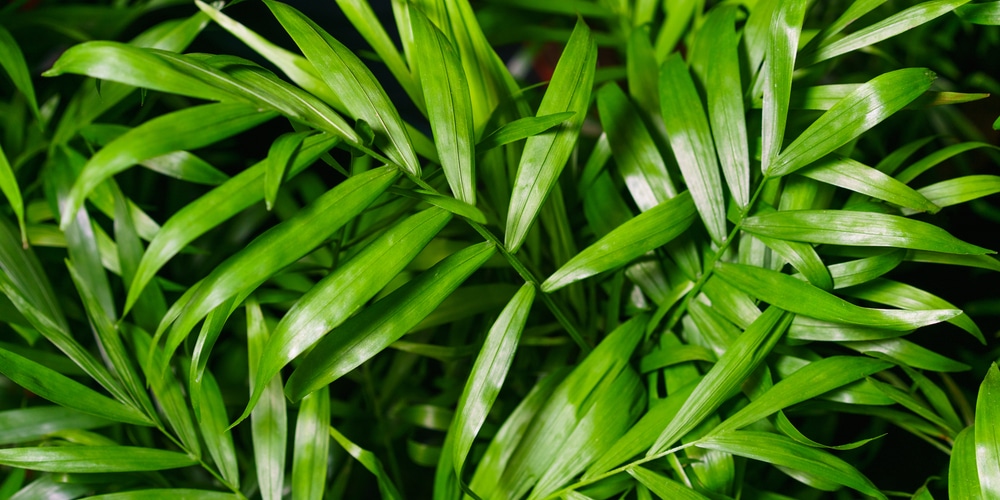The cat palm is similar to another Chamaedorea species known as cascade palm, Chamaedorea atrovirens. But unlike its sibling, Chamaedorea cataractarum displays more blades per cascading frond.
It also has light green nuances, which make this Mexican palm ideal for shady outdoor positions that need a touch of color.

Botanical Name: Chamaedorea Cataractarum
Common Name: Cat Palm, Cascade Palm, Cataract Palm, Mexican Hat Palm
Plant Type: Perennial
Flower Color: Yellow or White
Size When Mature: 48-72 inches (height), ~24 inches (width)
Bloom Time: Late Winter/Early Spring
Sun Requirements: Full and Partial Sun
USDA Hardiness Zones: 9b-11b
Soil PH Range: 6.1-7.8
Soil Type: Moist, Organic-rich, Well-draining
Water Needs: Low
Native Area: Southeastern Mexico, Central America
What you Need to Know About Chamaedorea Cataractarum
Cat palm is a lush palm with a trunkless and clustering growth habit that produces many long, thin blades on every frond. In detail, the stemless trunks split at the base of the plant, forming dense clusters. This is why this tropical plant needs at least a sunroom or a large window next to it to grow indoors.
Above all, you have to know that this palm is not a fast-growing plant. It will top off at about 6 feet. But it will take you a while to reach that tropical look you might see in the pictures.
Given that it is a low-maintenance plant, the Mexican hat palm is a pet-safe addition to any garden. But it will require you to attend to its watering needs religiously.
The yellowish, unscented flowers are valuable only if you want to harvest the seed pods that later develop on them. So, most growers remove them in order to prevent the plant from wasting energy on them.
The flower stalks appear in late winter and last for only a couple of months.
How to Care for a Cat Palm
Here’s everything you need to know about growing and caring for a thriving cat palm.
Light
A cascade palm will grow in low-light areas indoors. But it will not display a steady growth. Why? Because this palm needs bright indirect light and as much direct sunlight as it can get to thrive. But this species is a low-growing palm. So, you can keep it indoors in a low-light condition once it matures.
Young cat palms will do better outdoor with a 20% shade cloth to protect the small fronds.
Water and Soil Needs
Chamaedorea cataractarum prefers moist soil at all times. For clarity, the medium must not be soggy because the cat palm does not want to sit and soak in a tray of water all the time.
Consistency is the key to a healthy cataract palm. The best watering practice is to water the pot well until a stream of water comes out from the bottom. You can also use a water meter to check the first few inches.
If you water this plant once a week, you will probably find it does not need more than that. Plus, it is also a drought tolerant palm. So, it is better to wait than to overwater it.
Humidity-wise, this plant loves high levels of humidity. So, you will have to mist it a couple of times a week during spring and fall. Another option is to fill a saucer with water and put pebbles. So the plant does not sit in the water. The water will slowly evaporate and provide higher humidity around the plant.
This plant is not picky about soil pH. You can use any potting mix as long as it is slightly acidic, alkaline, or even neutral—betwenn 6.1 and 7.8.
Temperature Requirements
The cat palm is native to the jungles of Central America. In detail, it usually grows on stream banks in southeastern Mexico. So, it is best suited for warm weather locations like California and Florida.
You can plant this tropical plant in any outdoor garden in USDA zones 9b-11b.
A mature cataract palm will survive prolonged exposition to low temperatures, up to 25F, and thrive at 85F. Cold drafts and air conditioning can cause foliage damage. Usually, the cat palm shows signs of leaf damage or yellow leaves when the temperature drops below 50F. But a young specimen will need to overwinter indoors.
Fertilizer
In its natural habitat, the soil is not that rich. So, a half-strength dose of a well-balanced fertilizer (10-15-12) works well. You can fertilize your cat palm once a month during its vegetative stage. That is, spring through fall.
Slow-release fertilizer every two or three months also works great for a Chamaedorea cataractarum.
Common Diseases
When growing indoors, the cataract palm does not usually develop any disease. Pests, on the other hand, may get out of control quickly.
Stagnant air will favor spider mite activity and mealybug infestations. If you spot any pests, you need to wash the leaves with insecticidal soap. Otherwise, they will take over and destroy your plant. A clear sign of pest infestation is the leaves turning brown.
Fungal pathogens like the Cylindrocladium may cause leaf spots and blight in outdoor cat palms.
Cataract Palm Propagation
Most varieties of the Chamaedorea genus are also known as bamboo palms because of their thin clustering trunks. But more importantly, because of the tough roots make propagating a cat palm by division a tiresome job.
To propagate the Mexican hat palm, you will need a sharp sickle —or better yet, a pruning saw—and protective gloves. Loppers may be necessary for cutting more robust roots. That is, if the plant is more than three years old.
- Take the rootbound cat palm out of its container.
- Before you begin, inspect the roots to think about how you would like to divide the clumps.
- Cut a section like you would cut a pie. But do not worry about being gentle. The cataract palm is quite resilient and tolerates force when separating the roots. If you are dealing with an old plant, saw up the root ball in half.
- Make some slits to loosen the roots before putting the new plant in a pot with all-purpose potting soil. If you want to plant it in the ground, you do not need to prune or cut the roots.
Related Article: Indoor Palm Trees

